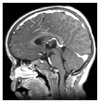Intracavitary Irradiation as a Safe Alternative for Cystic Craniopharyngiomas: Case Report and Review of the Literature
- PMID: 27366151
- PMCID: PMC4912999
- DOI: 10.1155/2016/3601395
Intracavitary Irradiation as a Safe Alternative for Cystic Craniopharyngiomas: Case Report and Review of the Literature
Abstract
Craniopharyngioma treatment remains a challenge for clinicians and patients. There are many treatment alternatives; however one of them (intracavitary irradiation) seeks to control this type of benign brain tumor using minimally invasive techniques, with the specific aim of avoiding causing significant damage to important structures surrounding the sellar/suprasellar region. We present the case of a 3-year-old patient with a predominantly cystic craniopharyngioma who underwent intracavitary irradiation by stereotactic placement. Using this approach, the patient showed a successful response with remission of headaches and hydrocephalus. A reduction in the size of the cyst was achieved, without deterioration of visual fields, with no hormonal supplementation being needed, and with no evidence of focal neurological signs.
Figures



Similar articles
-
Phosphorus-32 intracavitary irradiation of cystic craniopharyngiomas: current technique and long-term results.Int J Radiat Oncol Biol Phys. 1995 Sep 30;33(2):437-46. doi: 10.1016/0360-3016(95)00175-X. Int J Radiat Oncol Biol Phys. 1995. PMID: 7673031
-
Management of cystic craniopharyngiomas with phosphorus-32 intracavitary irradiation.Neurosurgery. 2004 Apr;54(4):813-20; discussion 820-2. doi: 10.1227/01.neu.0000114262.30035.af. Neurosurgery. 2004. PMID: 15046646
-
Management of cystic craniopharyngiomas with intracavitary irradiation with 32P.Arch Iran Med. 2008 Jan;11(1):30-4. Arch Iran Med. 2008. PMID: 18154420
-
Craniopharyngioma: a pathologic, clinical, and surgical review.Head Neck. 2012 Jul;34(7):1036-44. doi: 10.1002/hed.21771. Epub 2011 May 16. Head Neck. 2012. PMID: 21584897 Review.
-
Intracavitary brachytherapy of cystic craniopharyngiomas.J Neurosurg. 1992 Oct;77(4):545-50. doi: 10.3171/jns.1992.77.4.0545. J Neurosurg. 1992. PMID: 1527612 Review.
Cited by
-
Brachytherapy in paediatric craniopharyngiomas: a systematic review and meta-analysis of recent literature.Childs Nerv Syst. 2022 Feb;38(2):253-262. doi: 10.1007/s00381-021-05378-3. Epub 2021 Oct 7. Childs Nerv Syst. 2022. PMID: 34618201
References
-
- Bülow B., Attewell R., Hagmar L., Malmström P., Nordström C.-H., Erfurth E. M. Postoperative prognosis in craniopharyngioma with respect to cardiovascular mortality, survival, and tumor recurrence. Journal of Clinical Endocrinology and Metabolism. 1998;83(11):3897–3904. - PubMed
LinkOut - more resources
Full Text Sources
Other Literature Sources

